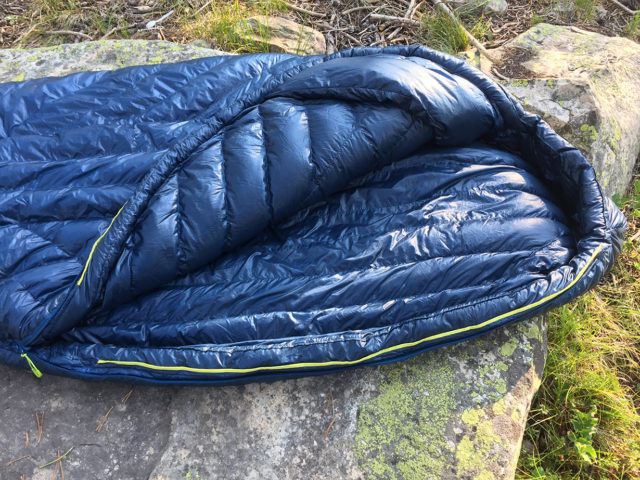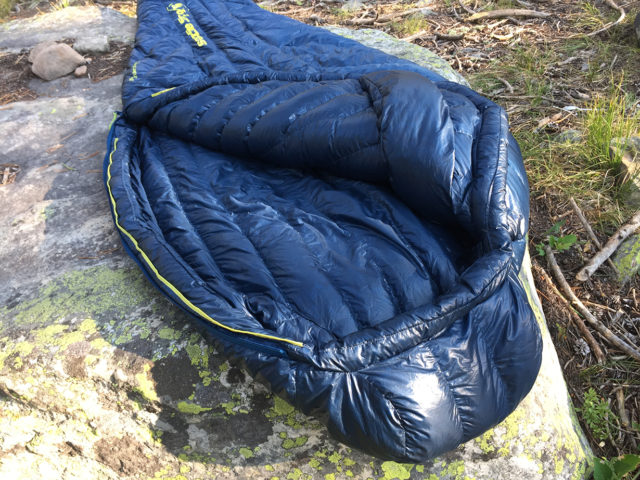
Big Agnes Flume UL 30
Stated Temperature Rating: 30°F
Stated Bag Weight:
- Size Regular: 624 g / 1 lb 6 oz
- Size Long: 680 g / 1 lb 8 oz
Stated Fill Weight:
- Size Regular: 340 g / 12 oz
- Size Long: 397 g / 14 oz
Stated Dimensions (size Regular):
- Length: 183 cm / 6 feet
- Shoulder Width: 152 cm / 60 in
- Hip Width: 137 cm / 54 in
- Foot Width: 91 cm / 36 in
Stated Compressed Bag Size (size Regular): 14×18 cm / 5.5×7 in
Materials:
- Insulation: 850-fill-power down w/ DownTek water-repellent finish
- Shell Fabric: Ultralight nylon ripstop w/ DWR finish
- Lining Fabric: Ultralight nylon ripstop
Stated Features:
- Shape allows for light weight and increased thermal value
- 3-D anti-snag draft tube prevents heat loss along the zipper
- Contoured hood baffles cradle the head for a more comfortable fit
- Oversized interior anti-draft collar
- DownTek™ water repellent down repels water while maintaining insulating value
- Low profile cordlock lets you un-cinch the hood with one hand
- Minimal 40” zipper cuts weight and reduces cold spots
- Two-way zipper allows easy access at waist for climbing harness tie-in
- Zipper Garage
- Interior fabric loops for sleeping bag liners
- Streamlined exterior loops for hang drying or storage
- Mesh storage sack & nylon stuff sack
Nights Tested: 40+
Locations: Solukhumbu, Nepal; Jackson Hole, WY; Wasatch & Uinta mountains, UT; Glacier National Park, MT
Intro
Finding the right sleeping bag often means making a lot of compromises. You can go with a very big, comfortable bag, but that’ll mean more weight in your pack. Or you could go with something ultralight, but that often means less room to move around, and less durability. Synthetic bags are better in wet weather, but down bags are lighter. Quilts and hybrid bags are lighter, but they’re often not as comfortable, warm, or user-friendly as traditional sleeping bags.
The Big Agnes Flume UL 30 is a top-tier ultralight 30° sleeping bag that’s designed to minimize weight and maximize warmth. At 624 grams for the Regular size, it’s an impressively light bag. But what do you lose by going so light? To find out, I took it with me throughout Nepal, the Wasatch mountains, Glacier National Park, and Teton National park to get an idea of how functional this ultralight bag is, and who would most appreciate it.
Weight & Packed Size
At a stated weight of 624 g for the Regular size and 680 g for the Long, the Flume 30 feels practically weightless, and a good compression sack reduces it to about the size of a cantaloupe.
For reference, below are some stated weights for a few other notable bags in this ultralight class. All stated weights are for the size Regular version of the bag, and we’ve included their stated temperature ratings in parentheses.
465 g Sea To Summit Spark SP II (35°F)
499 g Marmot Phase 30 (30°F)
540 g Western Mountaineering SummerLite (32°F)
610 g Feathered Friends Merlin UL 30 (30°F)
624 g Big Agnes Flume UL 30 (30°F)
648 g Mountain Hardwear Phantom Spark Down 28 (28°F)
661 g Marmot Hydrogen (30°F)
680 g Western Mountaineering MegaLite (30°F)
771 g Feathered Friends Kestrel UL 30 (30°F)
992 g Nemo Riff 30 (30°F)
The Flume UL 30 isn’t the absolute lightest bag in this category, but it is still very light. Plus, the Flume UL 30 is more comfortable than many stripped-down, ultralight bags (more on that later).
Design & Features
As an ultralight bag, the Flume UL 30 is unsurprisingly minimal when it comes to features.
The Flume’s zipper extends only about 2/3 down the length of the bag. Zippers are bulky and heavy, so decreasing zipper length is a logical way to increase packability. I did find myself getting hot on some summer nights without the ability to sleep with the bag fully unzipped. This proved to be my only major issue with the Flume, and Big Agnes makes it clear that this bag is for those who prioritize featherweight warmth, rather than maximum features and comfort. So the shorter zipper is just a factor you need to take into account / deal with in exchange for the Flume UL 30’s low weight.

The Flume’s well-designed, down-filled draft collar and a simple elastic cinch kept warm air in on cold nights. Another insulated draft tube runs the length of the zipper, and I was impressed by how infrequently the zipper caught it.
Fit & Comfort
I expected the Flume to be slim and relatively uncomfortable given its ultralight purpose. I’m 6’2″, 160 lbs and needed the Long version, and it proved to be surprisingly roomy and comfortable while still being so light.
I’m a (regrettably) active sleeper and switch positions fairly often, and I was generally more comfortable in the Flume than in my other bags (Sierra Designs Zissou 15 and Kelty Cosmic Down 4). The Flume also has the best hood of any bag i’ve ever used — it’s contoured and generally stays on my head despite my usual squirming.
Down Insulation
The Flume UL 30 uses 850-fill-power DownTek water-resistant down. I endured about 30 minutes of torrential rain and hail while in the Flume 30 without a tent one night in Wyoming, and while my buddy’s bag was completely soaked, I stayed dry. The DWR was surprisingly effective initially, and was probably the main reason I stayed dry. The down did lose a small amount of loft, but its water-resistant properties seemed to help. All that said, if you often find yourself in very wet environments, a synthetic bag might be a better (but heavier) choice.
Morning dew has overwhelmed the Flume UL 30’s DWR a few times, but I haven’t noticed any change in warmth. Overall, the Flume 30’s down has kept from clumping or bunching so far.
Big Agnes also uses what they call “Body Mapped Baffling”, which basically means that they add more down in key areas like the toe box. I am happy to report that there were very few times when I had cold feet in the bag, which could be attributed to the Body Mapping tech.
Warmth
I began testing the Flume in the Everest region of Nepal at elevations from 3000 feet to 16100 feet. In the high alpine, temperatures fell below freezing while nights in the lowlands were as hot as 80°F and muggy.
I was surprisingly comfortable in the Flume 30 on the coldest nights. Cinching the hood is easy (even when waking up cold and groggy), and that usually warmed me up quickly.
 There was only one frigid night (I’d guess around 15-20°F) during my entire Nepal trek when I had trouble sleeping in the Flume UL 30 due to the cold. At the lower elevations, the Flume was almost always too hot to sleep in, but I don’t think I’ve ever encountered comparable nighttime temperatures in the western U.S.
There was only one frigid night (I’d guess around 15-20°F) during my entire Nepal trek when I had trouble sleeping in the Flume UL 30 due to the cold. At the lower elevations, the Flume was almost always too hot to sleep in, but I don’t think I’ve ever encountered comparable nighttime temperatures in the western U.S.
Since returning to the states, I’ve been comfortable using the Flume on summer nights in the Wasatch, Glacier National Park, and Grand Teton National Park. It’s served me well as a versatile summer bag in the mountains of the western U.S., and it could also work as a 3-season bag in areas that see more moderate temperatures in the fall and spring.
Durability
The Flume UL 30’s ultralight ripstop fabric initially concerned me since it’s so thin, but after about 40 nights, the bag is still holding up well. I’ve only noticed one small hole near the feet, and haven’t had any tears from zipper snags. The Flume UL 30’s DWR is also still performing well.
As with all ultralight gear, we recommend being extra careful with a product like the Flume UL 30 since it’s not designed to handle a lot of abuse. But so far, I’ve been impressed by its durability.
Comparisons
The Flume is an ultralight, minimalist bag that is, well, still a real sleeping bag. The Brooks Range Elephant Foot and Patagonia Hybrid Sleeping Bag both offer ultralight performance, but they need to be combined with a heavily insulated jacket and therefore fill a smaller niche than the Flume 30.
Quilts like the Feathered Friends Flicker UL 20 are very light and great for hammock camping or trips where every gram matters, but they can be drafty and the warmth they provide around your feet depends on the integrity of their cordlocks. The Flume isn’t quite as light, but it provides the easy and reliable comfort of a traditional mummy bag.
Bottom Line
The Big Agnes Flume UL 30 is the best ultralight sleeping bag I’ve used. It’s impeccably designed to maximize warmth-to-weight, comfort, and packability. At $469, it’s by no means a budget bag, but its performance is well aligned with its high price. I’d recommend it for through-hikers and anyone who wants to minimize pack volume and weight without sacrificing much in terms of sleep quality.
